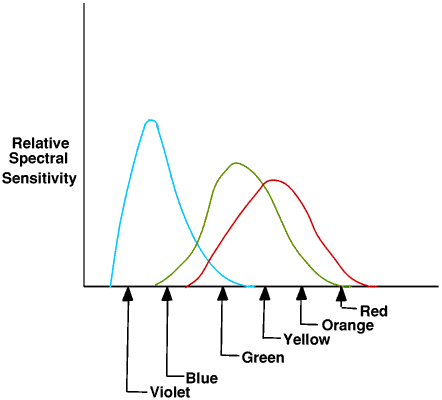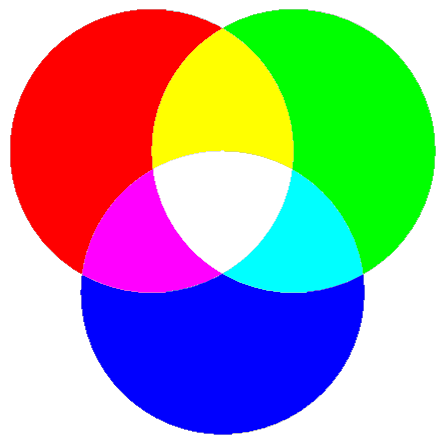Almost everything about the way in which we use colour, in art and photography, films and television, computers and colour monitors and printers, is actually about the way our eyes see colours not about colour itself. You can read about the theory of colour on another Page of this web Site and to link to it please click here ![]()
The back of our eye, the retina, consists of a very large number of light-sensitive receptors. These receptors produce electrical signals which are carried by the optic nerve to the brain. There are two types of receptors, called rods and cones because of their shape. Rods are very sensitive to light but not at all to colour; cones are sensitive to colour. Near the middle of the retina there are many cones and very few rods, at the edges of the retina there are very many rods but no cones.
The cones are very much less sensitive to light than the rods; this means that in poor light we cannot see colours very well; after dusk, even on a moonlit night, we cannot distinguish one colour from another (away from street lights etc of course!). Some religions such as Islam use this in order to decide when night has come. The rods however are very sensitive to light: this is why in very poor light we can see things more clearly if we look at them out of the side of our eye, so that the image is focused on the edge of the retina where there are lots of rods rather than in the middle of the retina where there are mostly cones.
There are three types of cone, called red, green and blue. The red cones are sensitive to the lower frequencies including red, the green cones are sensitive to the middle frequencies including green, and the blue cones are sensitive to the higher frequencies including blue. Here is a graph showing the sensitivity of the red, green and blue cones.

If yellow light enters the eye it will stimulate both the red cones and the green cones. But so will a mixture of red light and green light, that is, our eyes cannot tell the difference between yellow light and a mixture of red light and green light.
A white surface reflects all the light that falls on it, whatever its colour. If we take a piece of white card and shine a red light onto it we shall see a patch of red. The easiest way of obtaining a red light is to shine white light through a red filter. This allows the red light to pass through it but absorbs (or reflects) all the other colours.
If we shine a blue light onto it we shall see a patch of blue, and if we shine a green light onto it we shall see a patch of green. If we shine the lights onto the card so that the coloured patches overlap, where the red and green patches overlap we shall see yellow. Red and blue together appear as magenta, green and blue as cyan, and red, green and blue together as white.

We call red, green and blue the primary colours and yellow, cyan and magenta the secondary, or complementary colours - yellow is the complement to blue because yellow and blue make white. Similarly cyan is the complement to red and magenta the complement to green.
It is important to understand that we see these colours only because of the way that our eyes work. Although we cannot tell the difference between yellow light and a mixture of red light and green light, if we passed them both through a spectrometer the yellow light would appear as a single yellow line but the mixture of red and green would appear as a red line and a green line.
Yellow is a spectral colour, that is, it is present in a rainbow or spectrum; cyan and magenta are not. Spectrometers and spectral lines are discussed on the Page on Light and Colour.
Because our eyes contain only three sorts of cone we can in fact produce any colour at all just by mixing red light, green light and blue light in the right proportions, and this is how colour televisions and computer monitors work. We call this process additive colour mixing. We often refer to it as RGB colour mode, for red, green and blue.
Early colour televisions and computer monitors consisted of a screen coated with a very large number of very tiny spots of a special substance which glowed when struck by a beam of electrons. Some of these spots glowed red, some green and some blue. The electrons were fired at the screen by three electron guns: the red gun fired at the red spots, the green gun fired at the green spots and the blue gun fired at the blue spots. Although the technology has moved on since then it is still easiest to explain how a computer produces different colour in terms of red, green and blue guns.
Open a simple drawing program on your computer - if you are using a PC Paint will do, and these instructions are for Paint. Go to Colors, then Edit Colors and then Define Custom Colors. Notice the way the right hand set of numbers, labelled red, green and blue, change as you move the pointer around in the colours window: the numbers go from 256 for the gun fully on to 0 for the gun fully off. So white is all three guns fully on and black is all three guns fully off. Try to make magenta, yellow and cyan and then other colours.If we have a piece of white card it will reflect all the light that falls on it regardless of its colour. So it will look white under white light, and red under red light. But if we now print on it with a perfect red ink it will reflect only red light; a perfect red ink will absorb all colours other than red. So if we shine white light onto it it will look red, if we shine red light onto it it will look red, if we shine blue light onto it it will not reflect any light at all and will look black. If we mix a perfect red ink and and a perfect blue ink the red ink will absorb every colour except red and the blue ink will absorb every colour except blue, so between them they will absorb every colour and the surface will appear black. But if we take a perfect yellow ink it will reflect both red and green but absorb blue (or more accurately, the light reflected off it will stimulate the red and green cones but not the blue ones), and a cyan ink will reflect blue and green but absorb red. So a mixture of yellow ink and cyan ink will reflect only green. Similarly cyan ink and magenta ink will produce blue, and yellow ink and magenta ink will produce red. To get a white area you just leave it unprinted - but you must be using white paper of course! So in the same way that we can produce any colour by mixing red, green and blue lights in the right proportions we can produce any colour by mixing cyan, magenta and yellow inks in the right proportions. This is called subtractive colour mixing, because each ink is subtracting colours from the mixture.
So much for the theory; in practice we cannot get perfect yellow or cyan or magenta inks, because for example any real yellow ink will reflect a small amount of blue, so the colours do not come out exactly as we might expect. In particular it is impossible to get a true black. So most inkjet computer printers use four inks, cyan, magenta, yellow and a separate black. This is called CMYK - K for key rather than B for black as B is already used for blue in RGB. (Some colour printers with a separate black ink cartridge give you the option of continuing to print by mixing cyan, magenta and yellow if the black cartridge runs out. Do not take it unless you have to: the results are terrible and it is a very expensive way of making black.)
Photoreal ink jet printers, designed to produce very realistic colours from digital photographs, usually use six colours and black, two different cyans, two different magentas and two different yellows. (Professional photo labs, and other people very serious about digital photography, use a different sort of printer entirely - and usually Apple computers not PCs.)
Computer monitors use RGB but computer printers use CMYK, so a special program, called a printer driver, is needed to convert from one to the other. It is very important to use the correct driver and the right ink cartridges otherwise the colours may not come out how you expect. Professional artists and photographers use special drivers which allows them to control the RGB/CMYK conversion themselves so they can get exactly the effect they want.
Books and magazines and packaging materials etc are printed on huge printing presses. For simple work they may just use cyan, magenta, yellow and black inks; for better quality work they may also use other coloured inks. Some colours such as gold or purple are impossible to produce using only CMYK, so to get these colours they use extra inks as spot colours. Using spot colours increases the cost considerably.
As the different colours are printed onto the paper at different stages it is necessary for the operator to check that all the colours are lined up correctly: this is called registration. The operator also needs to check that all the inks are running freely. To help carry out these checks special control symbols, often small coloured squares or circles, are printed at the edge of each sheet, where they will be cut off when the paper is trimmed or hidden when the packet is glued together. You can often see them if you open up the glued tabs on, say, a packet of cornflakes. You can count the number of different coloured inks used: it can be interesting to compare those on a highly advertised brand name purchased at a major supermarket with those on a similar but unbranded product purchased at a discount warehouse.
Artists do not use CMYK; instead they use paints of different colours which they can mix on a palette to produce the exact colour they want. Watercolour paints are very easy to mix to get an exact colour and someone painting in watercolour will seldom use more than eight different coloured paints; oil paints are more difficult to mix so someone painting in oils may need more than this to get all the exact shades needed.
Ancient Egyptian artists invariably used only six colours. There was an artist’s palette in Tutankhamen’s tomb, with six holes for the six pots of colour, as well as several scribal palettes - Egyptian scribes used only two colours, black and red, so scribal palettes only had two holes.
Some people do not see colours in quite the same way as most other people: we call these people colour blind, although it is not a very accurate description and can be misleading. Colour blindness is discussed on another Page of this Web Site - to link to it please click here
The three sorts of cone, red, green and blue, take very slightly different times to respond to light, this is why in bright light moving or flashing patterns of black and white sometimes appear coloured. This is the the principle behind Benham's Disc.